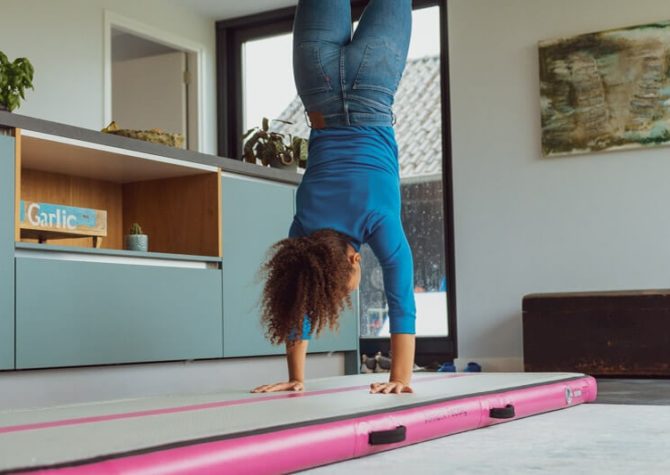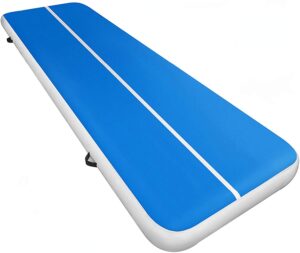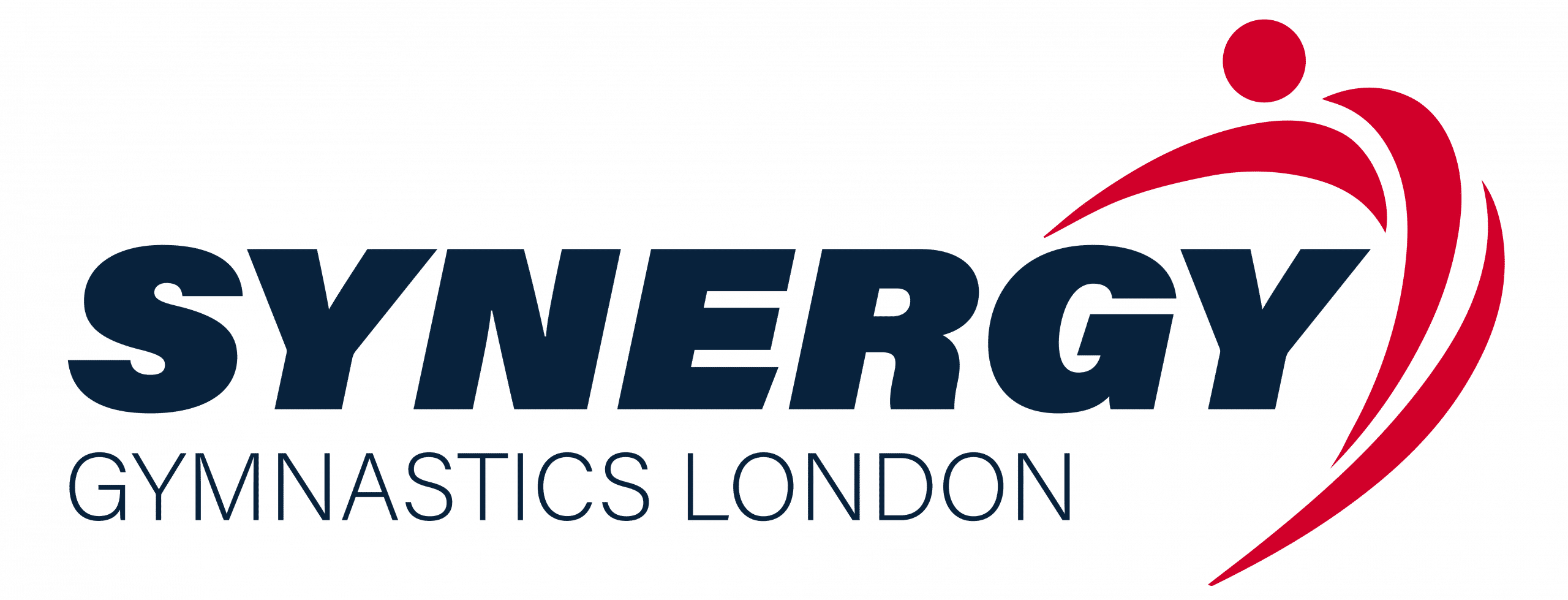
Many parents are looking to purchase home training equipment for their aspiring gymnast and quickly discover air tracks as a potential training aid. But before spending a significant amount of money on an an inflatable mat, you should be confident that it will be worth it.
The air track has swiftly risen to prominence over the past few years and in this comprehensive guide, we’ll delve deep into the intricacies of inflatable mats, ensuring you’re equipped with all the knowledge you need before considering one for your home.
What Exactly is an Air Track?
An air track is a rectangular piece of inflatable equipment that provides a safer and easier way to perform tumbling skills in gymnastics. They are long enough to link together moves like cartwheels, round-offs, back handsprings and flips.
Because they are inflatable they give extra bounce and air time in a similar way that a trampoline works. They also help provide softer landings compared to traditional gymnastics floors and tumble tracks.
When an inflatable track is not being used it can be deflated for easier storage just like a bounce house and other inflatables.

Benefits of an Air Track
Air tracks have many uses which is why the vast majority of professional gymnastics clubs use them. The major benefits include:
- Extra bounce makes it easier to attempt new skills.
- Softer impact means you can train for longer without getting tired
- Builds confidence
- Safer than landing on a harder / non inflatable surface
- Less risk of injury
- Requires only a small storage space when not in use
As well as being able to perform tumbling and acrobatic skills Air Tracks can also be used for other types of training. For example:
- Bridges / Walkovers from the higher air track down onto a lower floor
- Splits using the straight line for alignment
- Use the line for practicing spins that would normally be performed on a balance beam
- Conditioning exercises like push ups and v ups
Tumbling on an Air Track
You can do anything on an air track that you would normally practice on a regular gymnastics floor or tumble track. You will probably find it is easier to do the same skills on an air track because of the increased rebound. Some of the most popular skills are:
- Forward Roll
- Backward Roll
- Cartwheel
- Round Off
- Front Somi
- Back Somi
- Back Handspring
- Aerial
- Walkover
The great thing about an air track is that it will help you link multiple moves together for the first time. For example Round Off into Back Handspring.
How much do air tracks cost?
An air track for home use can cost anywhere from $80 for a cheap Amazon Track up to $1,000 for a premium quality brand.
Top-of-the-range air tracks found in professional gym facilities can cost as much as $4000 – $5000. The exact price will depend on its length and thickness among other things.
The longer the air track, the more it will cost.
Prices will also depend on the manufacturer and the quality of the product.
You will need to check if a pump is included with your mat. Cheaper versions often don’t and this is one way for them to keep the cost down. Electric pumps can be picked up for as little as $30-$40 but check compatibility before you buy a pump separately.
My top pick for an air track is the AirTrack Pro, closely followed by FbSport if you are on a tighter budget. Check out my full reviews of the best air tracks.
Other top air track brands include:
- AirTrack (also known as AirTrack Factory)
- AirTrack Nordic
- Speith
- American Athletic
- TumbleMat.com
- PE Redskaber
- Tracks 2000 (UK and Europe)
These are the main brands that manufacture themselves. Other companies may be selling these same products but with their branding printed on them or simply as approved dealers in a particular part of the world.
Many cheap air tracks found on Amazon look the same as the big brands but are way cheaper. They will probably not have been manufactured using the same premium quality materials used for an air track found in a professional gym. However, it is still worth considering Amazon to purchase an air track for home use, especially if you have a lower budget.
Are air tracks worth the money?
Yes, air tracks are often considered worth the investment for those committed to gymnastics, tumbling, or other athletic practices. They provide a safe and cushioned surface that helps reduce the risk of injuries, allowing users to practice their skills with confidence.
Additionally, their portability and ease of setup make them versatile training tools suitable for both indoor and outdoor use. However, the value derived from an air track largely depends on its quality, so it’s essential to choose a durable and well-constructed product from a reputable brand such as the ones below.
Buying Advice
The main factors to consider when buying an air track are length and thickness. Costs can range anywhere from $70 to $2,000 so most budgets can be catered for.
Air Track Length
The main factor that you will need to consider is how much space you have to use the air track. If you are using a limited size space then leave enough room to run up and land safely.
If you have no size constraints then you need to think about what skills you want to practice and which ones you hope to learn in the future. A common tumbling pass is round off, back handspring into a back somi.
- A good round off will travel around the same distance as your body length if you are lying down
- A good standing back handspring should travel at least twice your body length
- If you add a back somi after the BHS you should only travel a couple of feet maximum
A gymnast 55 inches (140cm) tall, needs around 16 feet to complete this common type of pass. This doesn’t include the run-up which can be done before taking the round off onto the air track. Smaller gymnasts probably won’t travel as far but bear in mind your gymnast won’t always stay small (despite what some people say!)
Air Track Thickness
Air tracks come in a range of thicknesses. The thickness refers to when it’s inflated and the height from floor to top of the track.
The greater the thickness the less chance you have of ‘bottoming out’ or feeling the floor under the track. You want to avoid bottoming out as it can cause injury and will give less bounce.
- 4” (10cm) thick are ideal for home use. You’ll get a good bounce and it’s easy to transport. In the gym, we use these on top of a mat or track to give additional comfort. At home, this thickness of track would work well on carpet or grass
- 8” (20cm) thickness will give added protection and bounce at home, especially on harder flooring such as laminate
- 12”-13” (30cm) height is commonly found in professional gyms. Generally, they are bouncier but they are heavier to set up and are less portable. They usually cost more as well.
- 90”-100” height is found in the older, original air tracks that came out in the early 2000’s. These require bigger electric pumps that are continuously switched on while the air track is being used. They are not suitable for home use as they are noisy and very heavy to move.
Air Floor v Air Track
A common question I get asked is whether there is a difference between an air floor and an air track. Actually, they can mean the same thing but it depends on the brand.
For some brands, air floors and air tracks are different shapes.
Air floors are often square like a traditional gymnastics floor.
Air tracks are usually long and narrow like a traditional rod tumble track.
Both will do the same thing and are used by the same sort of athletes so it’s just down to other factors like space when deciding which one is right for you.
Square Air floors are popular with trickers who like to create a flow between moves that might not be in a straight line.
More traditional tumbling that includes skills like round-off, back handsprings are performed in a straight line so the air track is more suitable (and cheaper). Check the pictures and dimensions on the product description to see whether it is long and narrow or square.
The Difference Between an Air Track v Tumbling Track
A traditional Tumbling Track in gymnastics is made from a metal frame with rods or fiberglass slats which compared to an inflatable air track feels more rigid.

In a competition, a full-length tumble track is 25 meters in length and allows space for up to 8 skills to be linked together. Air tracks on the other hand were developed for practice and training purposes rather than to be used in competitions.
The higher bounce and lower impact on the joints have meant the air track is now a standard piece of equipment in gymnastics facilities around the world. The fact they are portable and lightweight also means they are ideal for home use.
Try setting up a traditional tumble track in your backyard and you will soon have a space issue, not to mention the $25,000 price tag!
Air track v Trampoline
If you are only going to choose one piece of equipment out of the two, there are a few things to consider.
Air Time
A decent trampoline will give you way more height, bounce and air time than an air track. When I’m teaching a new tumbling skill I will start teaching it on a trampoline before transferring it to a fast track (basically a long trampoline and still bouncier than an air track). After the fast track, I move the skill to an air track and finally the rod tumble track.
The reason the trampoline is bouncier is the use of springs which allow the gymnast to depress the trampoline bed further down compared to an air track. The bigger the depression down, the greater the force created as it pings you back up again (as long as the springs are not worn out!)
Safety
An inflatable mat is probably less likely to cause injuries than a trampoline. The increased air time and smaller dimensions of a trampoline make it more likely for someone to be catapulted off the side or to land on their neck or head.
Cost
Generally speaking, a trampoline will be cheaper than an air track although there are plenty of examples where this is not the case. However, if you were to compare products of similar quality and brand, the trampoline will usually be cheaper.
Storage and Transport
An inflatable track can be rolled up and stored in a relatively small space. You can also pack it in the car and take it to a friend or the park. A trampoline won’t be able to do that!
Durability
This all depends on the manufacturer of a particular product but generally speaking, a well-maintained air track can last for as long as 10 years. I have an air track in the gym which we use a lot and is almost 15 years old. The pump has been replaced and the pressure is starting to decrease now but it shows that these are long-lasting pieces of equipment. A trampoline that is kept outside will be open to the weather elements and probably won’t last as long as an air track.
Final Thoughts
Air tracks are worth it if you want to spend extra time working on tumbling skills outside the gym. Even the cheaper versions found on Amazon are usually of decent quality and have good value for money however I would recommend using one of the more established brands if your budget allows it.
This will help ensure you have a product that will last a long time and provide the high rebound needed to learn those new skills.
FAQs
How do you inflate an Air Track?
Air tracks are inflated by an electric pump. The type varies depending on the exact track but most will have a valve on one side or the top. Once it’s inflated you pop the valve back on to keep the air in.
Some of the bigger air tracks found in professional gym facilities have electric blowers that continuously pump air in. These are noisier as the pump has to be kept on while the air track is in use. Most home versions use won’t use these bigger pumps though.
What does an air track feel like?
Air tracks feel somewhere in between a trampoline and a traditional gymnastics floor or tumble track. A trampoline is bouncier than an air track but an air track is bouncier than a traditional floor or track.
The material itself feels like other inflatables such as bouncy castles and inflatables in the pool. A good quality air track should feel smooth and sturdy.
Do air tracks pop easily?
No, it’s very rare for an air track to pop.
If using the one outside you must avoid leaving sharp objects like twigs and stones underneath. Contact with a sharp object could cause a puncture so some people place a tarpaulin on the ground first to give extra protection outside.
I would also advise not using outdoor shoes on an air track as they can cause a puncture if they have something sharp on the sole. If you prefer using shoes when training I would suggest having a pair of shoes that are only used inside.
It’s very unusual for an air track to pop when someone is jumping or tumbling on it, especially if you are using a well-known brand. The air tracks we use in our gym are made by Air Track Factory and are used a lot by teenagers and adults and we have never had one pop while in use.
Do air tracks deflate easily?
A good-quality air track will stay inflated for several hours. If you keep your one up overnight it will need some extra air before using it again the next day.
Over the long term (months and years) it is normal for air tracks to lose their original high pressure. This is usually down to stitching becoming frayed and air escaping while in use. This is why it is super important to invest in a good quality track that has been made with proper stitching and materials.
Can you put an air track on grass?
Yes, air tracks can be used outside on grass but check for sharp objects before unfolding your it. An additional thin mat or tarp is advisable and can be used underneath the mat.
If you are planning on taking the track outside you will still need an electric point to plug the pump into!
Can air tracks get wet?
Yes, you can put an air track on water and it will float (unless you have a puncture!) so will make a cool inflatable for the pool.
Water will make the track extremely slippery and I wouldn’t advise trying to perform any type of gymnastics when wet. It will make a fantastic slide though!!
- How To Get Over a Mental Block In Gymnastics: A Complete GuideGymnastics is a sport that requires not only physical strength and skill but also mental strength. When a gymnast feels like they cannot attempt a… Read more: How To Get Over a Mental Block In Gymnastics: A Complete Guide
- Find The Best Leotard For Girls (Guide)Finding an ideal leotard for girls isn’t just about picking a dazzling design that sparkles (although it does help!). The leotard has to fit perfectly,… Read more: Find The Best Leotard For Girls (Guide)
- The Best Gymnastics Shorts (Our Top Picks)The best gymnastics shorts are designed to be worn over the top of a leotard providing additional coverage around the upper legs, whilst allowing gymnasts… Read more: The Best Gymnastics Shorts (Our Top Picks)
- Decathlon Leotards – Are They Any Good?If you’re in the market for a new leotard, you may be wondering if Decathlon leotards are any good considering the low cost of their… Read more: Decathlon Leotards – Are They Any Good?
- A Complete Guide to Gymnastics Hand RipsAre you tired of dealing with painful gymnastics rips on your hands from training? Look no further – this article offers a comprehensive approach to… Read more: A Complete Guide to Gymnastics Hand Rips
- Is Gymnastics Dangerous? (Facts and Comparisons)Gymnastics is acknowledged as a highly technical and physically demanding sport. It inherently carries a risk of injury, which is why most coaches and clubs… Read more: Is Gymnastics Dangerous? (Facts and Comparisons)






